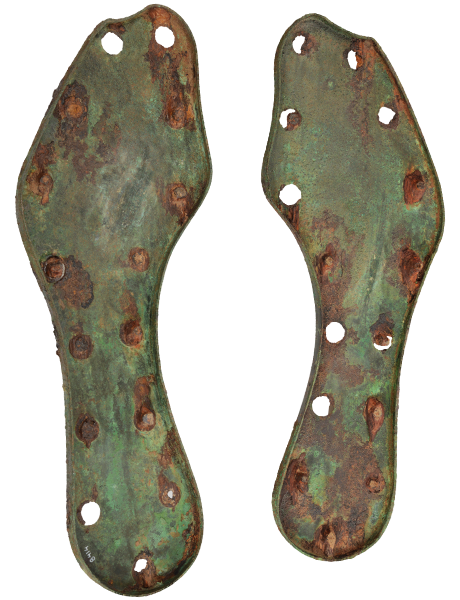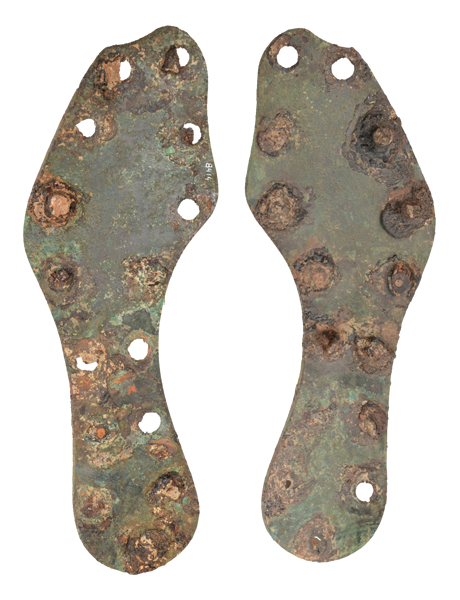Exhibit of the month
Treads of a woman’s sandals …
Bronze remains of a pair of shoes from Argolis
National Archaeological Museum
Collection of Metalwork, inv. no X8414
Provenance: found in a tomb in Argolis
Dimensions: Length: 0.024 m, Width: 0.04-0.08 m
Date: post 3rd century BC
Display location : Collection of Bronze Metalwork, Room 38, Showcase 56
Two bronze sheets cut in the shape of the sole is what has been preserved from a pair of elegant women’s sandals. Their dimensions correspond to a woman’s size (modern footwear size 36-37) and their provenance enables us to associate them with the “Argive sandals”, known as luxurious women’s shoes, according to ancient sources. The narrow border, 0.007 m in height, surrounding their contour would support the thin wooden sole. The surface that was in direct contact with the foot was lined with leather. Its bottom surface was fixed by fifteen iron flat-head nails, 2.5 cm in height approximately, arranged at regular intervals around the edges. Their outline at the front features, between the thumb toe and the pointer toe, the characteristic small indentation, in accordance with the standard type of the Hellenistic period, as evidenced by the accurate representation of the sandal with which the sensuous Aphrodite threatens the lovesick god Pan in the marble group dating to 100 BC from Delos.
The find of the bronze shoe-sole (kattymata) remains of the pair of sandals is not impressive at first sight. However, it is valuable and rare, as it constitutes one of the very few specimens of surviving ancient shoes. The majority of these comes from tombs or have been unearthed in sanctuaries having served as women’s votive offerings mainly. Our knowledge of the shoes of the ancient Greeks, their manufacturing techniques and shoemakers’ workshops comes from ancient texts, representations on vases and reliefs and bronze statues. The clay vases – oil containers in the form of a foot wearing sandal comprise a special category. According to the iconography of the ancient shoes, the diversity of types and their variations is as rich as their names, as attested by the ancient scholars.
The kind, shape, type and aesthetics, even their names range depending on the region, the period and the habits of society. The commonest type of male and female shoes were the sandals (or sandala). Elaborate or simple, they consisted of either thick or thin soles (kattymata) that were bound to the foot with leather straps. The endromides or embades, chiefly worn by horsemen and hunters, covered the foot and the leg resembling boots. Aside from these two main types there were different kinds, such as the crepides[1], the kothornoi[2], the karvatinae[3] etc.
Ancient works from the Collections of the National Archaeological Museum, of different sorts and materials, offer us the opportunity to gain insights into the variety of types of the ancient shoes and delve into their aesthetics, as these were formulated in the world of material culture of the past that dictated its own trends in everyday fashion.
[1] Crepida: an intermediate type, between sandal and closed flat footwear, with nails on the sole, and straps that were wrapped around and fastened up the shin. It was mainly warn by solders, hunters and travellers.
[2] Kothornos: was often worn by both women and men. It was a closed shoe that reached above the ankle, made of so soft leather that it suited men’s and women’s feet alike. Kothornos shoes were also part of the costume of tragic actors. Indeed, it was thought that this type of footwear was invented by Aeschylus to increase the high of the gods in theatrical performances, as it had a high sole.
[3] Karvatinae: thick shoes for the villagers, made of though leather, without sole.
Sappho Athanasopoulou
Bibliography:
Corso, Α., «Αρχαία Ελληνικά Υποδήματα», Αρχαιολογία και Τέχνες 82 (2002), 59-67.
De Ridder, Α., Catalogue des bronzes de la Societe Archeologique d’ Athenes, 1984, 490.
Erbacher, Κ., Griechisches Schuwerk, Wurzburg 1914, 25-45, σχέδ. 3-17.
Morrow, K.-D., Greek Footwear and the Dating of Sculpture, Madison,WI: University of Wisconsin Press, 1985, 63-64, 84-86, 114-117.
Πολυδεύκους, Ονομαστικόν VII 80-95.
Τουλούπα, Έ., «ΚΑΤΤΥΜΑΤΑ ΤΥΡΡΗΝΙΚΑ»-«ΚΡΗΠΙΔΕΣ ΑΤΤΙΚΑΙ», ΑΔ 28 (1973), A΄Μελέται, 134-135, πιν. 81 α.
Thompson, D.B., The House of Simon the Shoemaker, Archaeology 13 (1960), 234-240.
Χατζηδημητρίου Α., Παραστάσεις εργαστηρίων και εμπορίου στην εικονογραφία των Αρχαϊκών και Κλασικών Χρόνων, ΑΔ 92 (2005), 96-99.




